Aquifer Drilling Technologies: A Comparative Overview of 6 Basic Methods
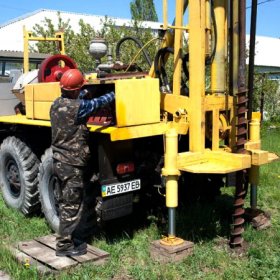
Wells are currently the main source of water for private land ownership. This is convenient for many reasons. Firstly, the water supply of the house does not depend on the central water supply, which often sins with accidents, and the water quality leaves much to be desired. Secondly, it is possible to "get" to deep aquifers with artesian water of perfect purity. Thirdly, you can regulate the amount of water necessary to supply your site with the help of the depth of the well and the selection of appropriate pumping equipment. One of the important points of laying a well in the area is a correctly selected method of drilling. Companies specializing in these works can offer you a variety of drilling options. The price and duration of drilling operations directly depend on the chosen method of laying the well. Having run into a “dishonest” company, there is a danger of overpaying for drilling operations, while choosing a more acceptable option for drilling can significantly reduce your financial investments in this event. How to avoid a miss in this matter of principle? We will tell you about the drilling methods, their features and prices - this will help you to navigate correctly when choosing the appropriate method of drilling the well in relation to the conditions of your site.
Speaking about the methods of drilling wells, it should be noted that they are all divided into two types - manual and mechanical. Manual methods are simpler and can be used for drilling shallow wells with your own hands, as they do not require the use of sophisticated equipment and heavy trucks. Such options for laying the source for the water supply system include: shock-rope, Abyssinian, rotary well drilling. Mechanical methods of well formation are characterized by the use of specialized equipment and are used to achieve deep artesian aquifers. These methods include: auger, rotary, core drilling and have proven themselves when passing heavy, rocky soils and in the construction of large diameter wells.
It's important to know! Manual drilling can be carried out to a depth not exceeding 20 m, since it is unlikely that a well can be laid deeper without the use of specialized equipment.
Content
Manual drilling methods
Method # 1 - Abyssinian Well
The Abyssinian method of creating a well is the simplest of all possible and consists in driving a small diameter steel rod into the ground - about 3 cm with a sharpened tip. From here comes another name for this type of well - the needle-well.The people often call this source of water the Abyssinian well. The main drawback of the Abyssinian method is the restriction on the possible depth of the well, which should not exceed 8 m. Without knowing exactly where the water is located on the site, it is possible to “riddle” it with needle-holes, without achieving the result. In addition, the small diameter of the Abyssinian well makes it impossible to use a submersible pump. This means that the only equipment for extracting water from such a well is a surface pump, which may not provide the proper pressure in the water supply system.
The following material will help you find water for drilling a well:https://aquatech.tomathouse.com/en/vodosnab/kolod-skvaj/kak-najti-vodu-dlya-skvazhiny.html
The main advantage of the needle-hole is the availability of the method for independent drilling and the presence of small holes in the rod, due to which it is used as both a casing pipe and a well filter.
Method # 2 - Shock Rope
Drilling a well in this way is widely exploited by both small companies and land owners by laying a well using the simplest techniques - tripods, winches and a driven glass in the form of a hollow pipe. The glass has a sharp edge, which, when driven into the ground, destroys the soil layers. The glass tube is suspended by means of a cable to the tripod and by means of a winch sharply lowers and rises. In this case, the earth from the wellbore is stuffed into a glass, so you need to periodically release it from the soil.
This drilling method is effective when the soil in the area is soft and viscous. If the soil is dry and loose, it does not linger in the cavity of the pipe - in this case, instead of a glass, a bailer is used, which grabs the rock from the wellhead and raises it to the surface. Shock-rope drilling is time-consuming, lengthy and expensive, but also the most high-quality type of well channel creation.
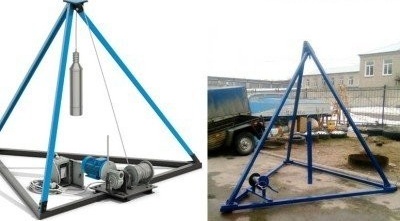
During shock-rope drilling, the driven glass is fixed on the cable and with the help of a winch it lowers into the face and rises - this is how the well channel is formed
Method # 3 - rotary drilling
A fairly simple way, available for laying wells manually - rotary well drilling. In this case, a drill similar to a large drill bit is used to form the wellbore, which “bites” into the ground by rotation and makes a vertical channel in it to the aquifer. Such a spiral drill is effective when drilling wells in loamy and gravel soils. If on the site there are sandy and loose soils, then the well is laid using a drill-spoon - a cylinder with spiral holes.
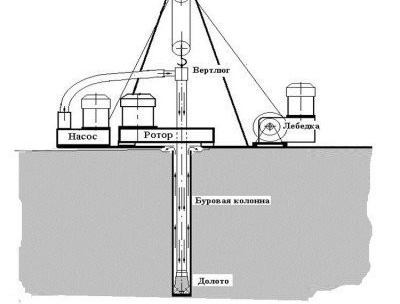
While the bit rotates and forms the wellhead, the pump feeds clay solution into the column to flush and strengthen the walls of the well.
Read more about the principles of creating the Abyssinian well here:https://aquatech.tomathouse.com/en/vodosnab/kolod-skvaj/abissinskij-kolodec-svoimi-rukami.html
Mechanical drilling methods
Drilling technologies using carbide nozzles for a drill and heavy equipment are mechanical and are used to create deep artesian wells - the so-called limestone wells. These wells are characterized by high productivity and excellent water quality.
Method # 1 - core drilling
The most effective method of mechanical drilling options used for laying wells of great depth (up to 1000 m) in rock formations is core drilling, which is performed by rotating a drill with a nozzle in the form of a high-strength diamond core. The main advantage of this type of drilling is its high penetration rate, compact and maneuverable drilling rigs, high drilling efficiency due to the destruction of the rock is not a continuous bottom, but annular, when the excavation is a solid rod (core).
The disadvantages of core drilling include a small (up to 16 cm) borehole diameter and rapid wear of drill bits. The cost of driving 1 m.p. column method varies from 300 to 500 rubles. and depends on the complexity of the rocks and the depth of the well.
Method # 2 - mechanical rotary drilling
Rotary drilling is performed using a bit mounted on a rotating drill, which is driven by a special mechanism - the rotor. This method of drilling aquifers is used in extremely hard soils and is one of the most productive methods. The use of the rotary method is the key to achieving deep aquifers with clean water without iron compounds and high stable well production. The disadvantage of this drilling technology is the high clay and water consumption for kneading the flushing solution and the ingress of clay particles into the aquifer when washing the wellbore.
There are also certain difficulties when performing rotary drilling in the winter due to the need to heat the flushing solution. The cost of the passage of 1 mp for rotary drilling is about 2000 rubles.
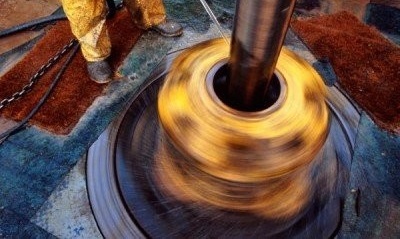
The bit must be constantly cooled with water (there is a person on the left who is watering it from the hose)
Method # 3 - auger drilling
The most convenient method used when laying shallow wells in loose soils is the auger method of drilling wells. The auger is a rod with a cutter at the end and blades that help remove soil from the borehole channel.
At the final stage of drilling, cementing is carried out. You can read about the technology here:https://aquatech.tomathouse.com/en/vodosnab/kolod-skvaj/cementirovanie-skvazhin.html
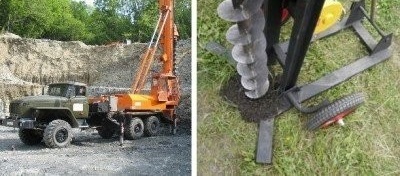
Drilling station for auger drilling can be of impressive size, requiring installation on heavy special equipment, and compact dimensions. Collapsible mini-drill rigs are often used by independent masters to drill wells using the auger method.
The auger method is the most commonly used solution for laying aquifers on a private land plot. When auger drilling works are performed quickly, do not require highly skilled workers and the use of bulky equipment. In addition, this method does not involve the use of additional equipment to remove destroyed rock from the wellhead.
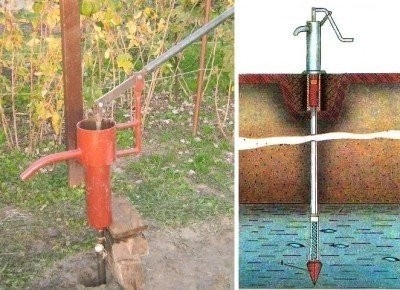
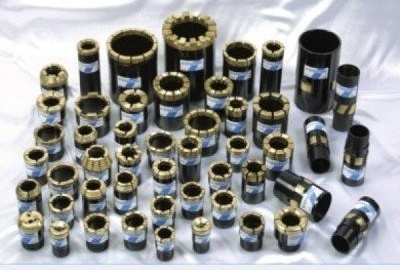

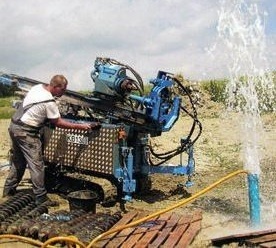
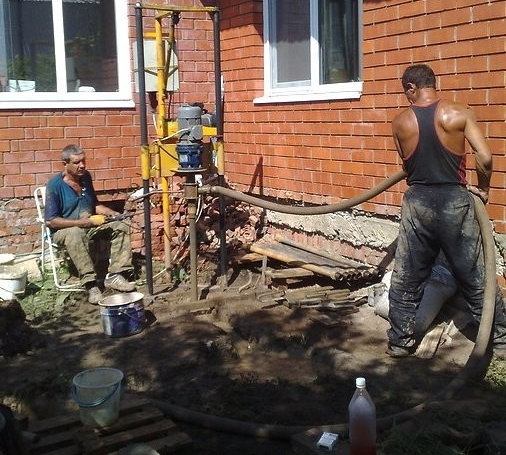
1 comment